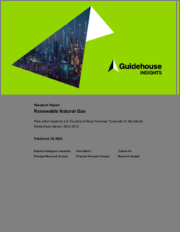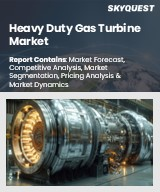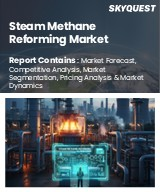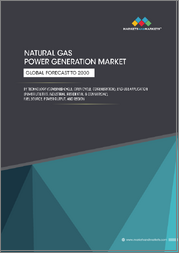
|
시장보고서
상품코드
1527899
재생천연가스(RNG) : 세계 바이오메탄 시장의 생산능력과 설비 판매수익 예측(2024-2033년)Renewable Natural Gas: Production Capacity and Equipment Sales Revenue Forecasts for the Global Biomethane Market, 2024-2033 |
||||||
바이오메탄으로도 알려진 재생 천연가스(RNG)는 광범위한 산업에서 바로 사용할 수 있는 탈탄소 솔루션을 제공합니다. RNG는 동물성 폐기물이나 음식물 쓰레기와 같은 유기물이 분해될 때 발생하는 바이오가스로부터 불순물을 제거하여 제조됩니다. 바이오가스가 파이프라인 품질의 메탄가스로 개선되면 RNG가 되어 기존의 화석 천연가스와 완벽하게 호환됩니다. 드롭인 연료인 RNG는 파이프라인과 지하 저장 시설, 가스 터빈, 가전제품 등 기존 가스 인프라와 호환됩니다. 재생 가스는 다른 탈탄소화 옵션이 거의 없는 에너지 절감이 어려운 섹터에 특히 적합합니다.
많은 개발도상국들이 조리나 난방에 바이오가스를 계속 사용하고 있는 한편, 유럽과 북미는 RNG와 같은 재생연료의 사용을 장려하기 위한 법정비를 일찍부터 진행해 왔습니다. 오늘날 시장 수요는 이러한 정책을 거의 반영합니다. RNG 시장 발전의 가장 큰 우려 사항은 높은 생산 비용 외에도 원료의 확장 성을 포함합니다. 생산자는 장기간에 걸쳐 안정적인 원료 공급이 필요하지만, 농업 활동의 주기적 특성을 고려하면 어려울 수 있습니다. 또한 새로운 수요와 RNG 공급업체의 출현에 따라 원료를 둘러싼 경쟁도 격화될 것으로 예상됩니다.
이 보고서는 세계의 RNG 생산 능력 증강 동향과 설비의 판매 수익을 예측하고 있습니다(2024-2033년). 시장 예측은 계획중인 RNG 생산 능력 분석과 업계 리더와의 전화 및 직접 인터뷰를 포함한 1 차 조사를 기반으로합니다. 예측 결과는 지역별·생산 경로별·최종 용도별로 구분하여 제공되고 있습니다.
목차
제1장 주요 요약
제2장 시장 문제
- 소개
- 성장 촉진요인
- 환경상의 이점
- 기존 인프라
- 복수의 활용 영역
- 정책 지원
- 억제요인
- 고비용
- 원료 조달
- 정책에 따른 사일로화
- 차량의 전동화
- 가격
- 비용
- 시장 가격
- 기타 비즈니스 문제
- 원료
- 탄소 강도
제3장 산업 밸류체인
- 밸류체인
- 경쟁 구도
- 기업 합병·인수(M&A) 활동
- 비즈니스 모델의 진화
제4장 시장 예측
- 조사 방법
- 세계 시장 개요
- RNG의 제조 설비 : 지역별
- RNG의 제조 설비 : 생산 경로별
- RNG 생산량 : 최종 용도별
- 북미
- 유럽
- 아시아태평양
- 라틴아메리카
- 중동 및 아프리카
제5장 결론 및 제안
- 3개의 큰 포인트
- 추천 사항
- 정책 입안자는 수송 이외에서의 RNG의 이용에 인센티브를 주어야 한다
- 원재료 공급자는 시장 기회를 인식하고 획득해야
- 가스기업은 RNG를 라이프라인으로 받아들여야 한다
- 탈탄소화 목표를 달성하기 위해서는 가스의 주요 수요가가 RNG를 도입할 필요가 있다
제6장 두자어 및 약어 일람
제7장 목차
제8장 도표
제9장 조사 범위, 정보 출처와 조사 방법, 주석
JHS 24.08.14Renewable natural gas (RNG), also known as biomethane, offers an immediate decarbonization solution to a wide range of industries. RNG is produced by removing the impurities from biogas, which is released during the decomposition of organic matter such as animal or food waste. Once the biogas is upgraded to make a stream of pipeline quality methane, it becomes RNG, which is completely interchangeable with conventional fossil natural gas. As a drop-in fuel, RNG is compatible with existing gas infrastructure, including pipelines, storage caverns, gas turbines, and home appliances. Renewable gas is especially well suited for hard-to-abate sectors, where few other decarbonization options exist.
While many developing countries will continue to use biogas for cooking and heating, Europe and North America were early movers on crafting legislation to help incentivize the use of renewable fuels such as RNG. Market demand today largely reflects those policies. In addition to high production costs, the scalability of feedstocks is a primary concern about the development of the RNG market. Producers need a steady long-term supply of feedstock, which can be a challenge considering the cyclical nature of some agriculture activities. In addition, competition over feedstocks will increase as new demand and RNG suppliers emerge.
This Guidehouse Insights report provides forecasts for RNG production capacity additions and equipment sales revenues from 2024-2033. Forecasts are based on an analysis of planned RNG production capacity and primary research that includes phone and in-person interviews with industry leaders. Forecasts have been segmented by global region, production pathways, and end-use application.
Table of Contents
1. Executive Summary
1.1 Market Prelude
- 1.2 Market Forecast
2. Market Issues
- 2.1 Introduction
- 2.2 Drivers
- 2.2.1 Environmental Benefits
- 2.2.2 Existing Infrastructure
- 2.2.3 Multiple Applications
- 2.2.4 Policy Support
- 2.3 Barriers
- 2.3.1 High Costs
- 2.3.2 Feedstock Sourcing
- 2.3.3 Siloed by Policy
- 2.3.4 Vehicle Electrification
- 2.4 Pricing
- 2.4.1 Costs
- 2.4.2 Market Value
- 2.5 Other Business Issues
- 2.5.1 Feedstocks
- 2.5.2 Carbon Intensity
3. Industry Value Chain
- 3.1 Value Chain
- 3.2 Competitive Landscape
- 3.2.1 M&A Activities
- 3.2.2 Business Model Evolution
- 3.2.2.1 Transportation
- 3.2.2.2 Gas Grid Operators
- 3.2.2.3 Commercial, Industrial, and Corporate Buying
4. Market Forecasts
- 4.1 Methodology
- 4.2 Global Market Overview
- 4.2.1 RNG Production Equipment by Region
- 4.2.2 RNG Production Equipment by Production Pathway
- 4.2.3 RNG Production by End-Use Application
- 4.3 North America
- 4.4 Europe
- 4.5 Asia Pacific
- 4.6 Latin America
- 4.7 Middle East & Africa
5. Conclusions and Recommendations
- 5.1 Three Big Takeaways
- 5.2 Recommendations
- 5.2.1 Policymakers Should Offer Incentives for Using RNG Outside Transportation
- 5.2.2 Feedstock Suppliers Must Recognize the Opportunity and Seize It
- 5.2.3 Gas Utilities Should Embrace RNG as a Lifeline
- 5.2.4 Large Gas Consumers Must Adopt RNG to Reach Decarbonization Goals




















